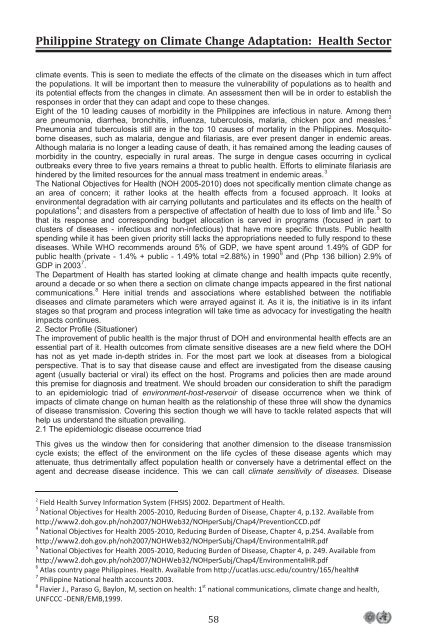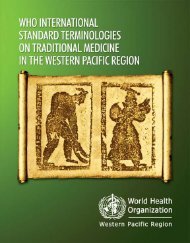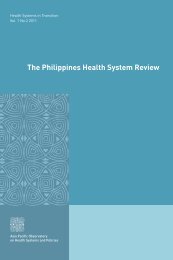Untitled - DOH
Untitled - DOH
Untitled - DOH
- No tags were found...
You also want an ePaper? Increase the reach of your titles
YUMPU automatically turns print PDFs into web optimized ePapers that Google loves.
Philippine Strategy on Climate Change Adaptation: Policy Health Handbook Sectorclimate events. This is seen to mediate the effects of the climate on the diseases which in turn affectthe populations. It will be important then to measure the vulnerability of populations as to health andits potential effects from the changes in climate. An assessment then will be in order to establish theresponses in order that they can adapt and cope to these changes.Eight of the 10 leading causes of morbidity in the Philippines are infectious in nature. Among themare pneumonia, diarrhea, bronchitis, influenza, tuberculosis, malaria, chicken pox and measles. 2Pneumonia and tuberculosis still are in the top 10 causes of mortality in the Philippines. Mosquitobornediseases, such as malaria, dengue and filariasis, are ever present danger in endemic areas.Although malaria is no longer a leading cause of death, it has remained among the leading causes ofmorbidity in the country, especially in rural areas. The surge in dengue cases occurring in cyclicaloutbreaks every three to five years remains a threat to public health. Efforts to eliminate filariasis arehindered by the limited resources for the annual mass treatment in endemic areas. 3The National Objectives for Health (NOH 2005-2010) does not specifically mention climate change asan area of concern; it rather looks at the health effects from a focused approach. It looks atenvironmental degradation with air carrying pollutants and particulates and its effects on the health ofpopulations 4 ; and disasters from a perspective of affectation of health due to loss of limb and life. 5 Sothat its response and corresponding budget allocation is carved in programs (focused in part toclusters of diseases - infectious and non-infectious) that have more specific thrusts. Public healthspending while it has been given priority still lacks the appropriations needed to fully respond to thesediseases. While WHO recommends around 5% of GDP, we have spent around 1.49% of GDP forpublic health (private - 1.4% + public - 1.49% total =2.88%) in 1990 6 and (Php 136 billion) 2.9% ofGDP in 2003 7 .The Department of Health has started looking at climate change and health impacts quite recently,around a decade or so when there a section on climate change impacts appeared in the first nationalcommunications. 8 Here initial trends and associations where established between the notifiablediseases and climate parameters which were arrayed against it. As it is, the initiative is in its infantstages so that program and process integration will take time as advocacy for investigating the healthimpacts continues.2. Sector Profile (Situationer)The improvement of public health is the major thrust of <strong>DOH</strong> and environmental health effects are anessential part of it. Health outcomes from climate sensitive diseases are a new field where the <strong>DOH</strong>has not as yet made in-depth strides in. For the most part we look at diseases from a biologicalperspective. That is to say that disease cause and effect are investigated from the disease causingagent (usually bacterial or viral) its effect on the host. Programs and policies then are made aroundthis premise for diagnosis and treatment. We should broaden our consideration to shift the paradigmto an epidemiologic triad of environment-host-reservoir of disease occurrence when we think ofimpacts of climate change on human health as the relationship of these three will show the dynamicsof disease transmission. Covering this section though we will have to tackle related aspects that willhelp us understand the situation prevailing.2.1 The epidemiologic disease occurrence triadThis gives us the window then for considering that another dimension to the disease transmissioncycle exists; the effect of the environment on the life cycles of these disease agents which mayattenuate, thus detrimentally affect population health or conversely have a detrimental effect on theagent and decrease disease incidence. This we can call climate sensitivity of diseases. Disease2 Field Health Survey Information System (FHSIS) 2002. Department of Health.3 National Objectives for Health 2005-2010, Reducing Burden of Disease, Chapter 4, p.132. Available fromhttp://www2.doh.gov.ph/noh2007/NOHWeb32/NOHperSubj/Chap4/PreventionCCD.pdf4 National Objectives for Health 2005-2010, Reducing Burden of Disease, Chapter 4, p.254. Available fromhttp://www2.doh.gov.ph/noh2007/NOHWeb32/NOHperSubj/Chap4/EnvironmentalHR.pdf5 National Objectives for Health 2005-2010, Reducing Burden of Disease, Chapter 4, p. 249. Available fromhttp://www2.doh.gov.ph/noh2007/NOHWeb32/NOHperSubj/Chap4/EnvironmentalHR.pdf6 Atlas country page Philippines. Health. Available from http://ucatlas.ucsc.edu/country/165/health#7 Philippine National health accounts 2003.8Flavier J., Paraso G, Baylon, M, section on health: 1 st national communications, climate change and health,UNFCCC -DENR/EMB,1999.58 2
















